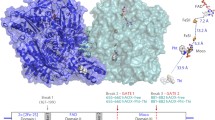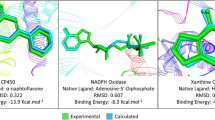Abstract
Background
Aldehyde oxidase (AOX) is an important molybdenum-containing enzyme with high similarity with xanthine oxidase (XO). AOX involved in the metabolism of a large array of aldehydes and N-heterocyclic compounds and its activity is highly substrate-dependent.
Objectives
The aim of this work was to study the effect of five important phenothiazine drugs on AOX activity using benzaldehyde and phenanthridine as aldehyde and N-heterocyclic substrates, respectively.
Methods
The effect of trifluperazine, chlorpromazine, perphenazine, thioridazine and promethazine on rat liver AOX was measured spectrophotometrically. To predict the mode of interactions between the studied compounds and AOX, a combination of homology modeling and a molecular docking study was performed.
Results
All phenothiazines could inhibit AOX activity measured either by phenanthridine or benzaldehyde with almost no effect on XO activity. In the case of benzaldehyde oxidation, the lowest and highest half-maximal inhibitory concentration (IC50) values were obtained for promethazine (IC50 = 0.9 µM), and trifluoperazine (IC50 = 3.9 µM), respectively; whereas perphenazine (IC50 = 4.3 µM), and trifluoperazine (IC50 = 49.6 µM) showed the strongest and weakest inhibitory activity against AOX-catalyzed phenanthridine oxidation, respectively. The in silico findings revealed that the binding site of thioridazine is near the dimer interference, and that hydrophobic interactions are of great importance in all the tested phenothiazines.
Conclusion
The five studied phenothiazine drugs showed dual inhibitory effects on AOX activity towards aldehydes and N-heterocycles as two major classes of enzyme substrates. Most of the interactions between the phenothiazine-related drugs and AOX in the binding pocket showed a hydrophobic nature.



Similar content being viewed by others
Change history
18 January 2019
Unfortunately, the original article was published with error in author names. The author names are corrected here by this correction paper. The original article has been corrected.
References
Argikar UA, Potter PM, Hutzler JM, Marathe PH. Challenges and opportunities with non-CYP enzymes aldehyde oxidase, carboxylesterase, and udp-glucuronosyltransferase: focus on reaction phenotyping and prediction of human clearance. AAPS J. 2016;18(6):1391–405. https://doi.org/10.1208/s12248-016-9962-6.
Cerny MA. Prevalence of non-cytochrome P450-mediated metabolism in food and drug administration-approved oral and intravenous drugs: 2006–2015. Drug Metab Dispos. 2016;44(8):1246–52. https://doi.org/10.1124/dmd.116.070763.
Gan J, Ma S, Zhang D. Non-cytochrome P450-mediated bioactivation and its toxicological relevance. Drug Metab Rev. 2016;48(4):473–501. https://doi.org/10.1080/03602532.2016.1225756.
Taylor AP, Robinson RP, Fobian YM, Blakemore DC, Jones LH, Fadeyi O. Modern advances in heterocyclic chemistry in drug discovery. Org Biomol Chem. 2016;14(28):6611–37. https://doi.org/10.1039/c6ob00936k.
Rashidi MR, Smith JA, Clarke SE, Beedham C. In vitro oxidation of famciclovir and 6-deoxypenciclovir by aldehyde oxidase from human, guinea pig, rabbit, and rat liver. Drug Metab Dispos. 1997;25(7):805–13.
Beedham C, Miceli JJ, Obach RS. Ziprasidone metabolism, aldehyde oxidase, and clinical implications. J Clin Psychopharmacol. 2003;23(3):229–32. https://doi.org/10.1097/01.jcp.0000084028.22282.f2.
Rashidi MR, Beedham C, Smith JS, Davaran S. In vitro study of 6-mercaptopurine oxidation catalysed by aldehyde oxidase and xanthine oxidase. Drug Metab Pharmacokinet. 2007;22(4):299–306.
Klecker RW, Cysyk RL, Collins JM. Zebularine metabolism by aldehyde oxidase in hepatic cytosol from humans, monkeys, dogs, rats, and mice: influence of sex and inhibitors. Bioorg Med Chem. 2006;14(1):62–6. https://doi.org/10.1016/j.bmc.2005.07.053.
Jordan CG, Rashidi MR, Laljee H, Clarke SE, Brown JE, Beedham C. Aldehyde oxidase-catalysed oxidation of methotrexate in the liver of guinea-pig, rabbit and man. J Pharm Pharmacol. 1999;51(4):411–8.
Garattini E, Terao M. Increasing recognition of the importance of aldehyde oxidase in drug development and discovery. Drug Metab Rev. 2011;43(3):374–86. https://doi.org/10.3109/03602532.2011.560606.
Garattini E, Terao M. The role of aldehyde oxidase in drug metabolism. Expert Opin Drug Metab Toxicol. 2012;8(4):487–503. https://doi.org/10.1517/17425255.2012.663352.
Rashidi MR, Soltani S. An overview of aldehyde oxidase: an enzyme of emerging importance in novel drug discovery. Expert Opin Drug Discov. 2017;12(3):305–16. https://doi.org/10.1080/17460441.2017.1284198.
Barr JT, Jones JP. Inhibition of human liver aldehyde oxidase: implications for potential drug–drug interactions. Drug Metab Dispos. 2011;39(12):2381–6. https://doi.org/10.1124/dmd.111.041806.
Glintborg B, Andersen SE, Dalhoff K. Drug–drug interactions among recently hospitalised patients–frequent but mostly clinically insignificant. Eur J Clin Pharmacol. 2005;61(9):675–81. https://doi.org/10.1007/s00228-005-0978-6.
McCance-Katz EF, Sullivan LE, Nallani S. Drug interactions of clinical importance among the opioids, methadone and buprenorphine, and other frequently prescribed medications: a review. Am J Addict. 2010;19(1):4–16. https://doi.org/10.1111/j.1521-0391.2009.00005.x.
Cascorbi I. Drug interactions–principles, examples and clinical consequences. Dtsch Arzteblatt Int. 2012;109(33–34):546–55. https://doi.org/10.3238/arztebl.2012.0546 (quiz 56).
Siah M, Farzaei MH, Ashrafi-Kooshk MR, Adibi H, Arab SS, Rashidi MR, et al. Inhibition of guinea pig aldehyde oxidase activity by different flavonoid compounds: an in vitro study. Bioorg Chem. 2016;64:74–84. https://doi.org/10.1016/j.bioorg.2015.12.004.
Tayama Y, Sugihara K, Sanoh S, Miyake K, Morita S, Kitamura S, et al. Effect of tea beverages on aldehyde oxidase activity. Drug Metab Pharmacokinet. 2011;26(1):94–101.
Nirogi R, Kandikere V, Palacharla RC, Bhyrapuneni G, Kanamarlapudi VB, Ponnamaneni RK, et al. Identification of a suitable and selective inhibitor towards aldehyde oxidase catalyzed reactions. Xenobiotica. 2014;44(3):197–204. https://doi.org/10.3109/00498254.2013.819594.
Obach RS, Huynh P, Allen MC, Beedham C. Human liver aldehyde oxidase: inhibition by 239 drugs. J Clin Pharmacol. 2004;44(1):7–19. https://doi.org/10.1177/0091270003260336.
Johns DG. Human liver aldehyde oxidase: differential inhibition of oxidation of charged and uncharged substrates. J Clin Invest. 1967;46(9):1492–505. https://doi.org/10.1172/jci105641.
Barr JT, Jones JP. Evidence for substrate-dependent inhibition profiles for human liver aldehyde oxidase. Drug Metab Dispos. 2013;41(1):24–9. https://doi.org/10.1124/dmd.112.048546.
Pirouzpanah S, Rashidi MR, Delazar A, Razavieh SV, Hamidi A. Inhibitory effects of Ruta graveolens L. extract on guinea pig liver aldehyde oxidase. Chem Pharm Bull. 2006;54(1):9–13.
Johnson C, Stubley-Beedham C, Stell JG. Hydralazine: a potent inhibitor of aldehyde oxidase activity in vitro and in vivo. Biochem Pharmacol. 1985;34(24):4251–6.
Altschul SF, Gish W, Miller W, Myers EW, Lipman DJ. Basic local alignment search tool. J Mol Biol. 1990;215(3):403–10. https://doi.org/10.1016/s0022-2836(05)80360-2.
Wu CH, Apweiler R, Bairoch A, Natale DA, Barker WC, Boeckmann B, et al. The Universal Protein Resource (UniProt): an expanding universe of protein information. Nucleic Acids Res. 2006;34((Database issue)):D187–91. https://doi.org/10.1093/nar/gkj161.
Coelho C, Foti A, Hartmann T, Santos-Silva T, Leimkuhler S, Romao MJ. Structural insights into xenobiotic and inhibitor binding to human aldehyde oxidase. Nat Chem Biol. 2015;11(10):779–83. https://doi.org/10.1038/nchembio.1895.
Sievers F, Wilm A, Dineen D, Gibson TJ, Karplus K, Li W, et al. Fast, scalable generation of high-quality protein multiple sequence alignments using Clustal Omega. Mol Syst Biol. 2011;7:539. https://doi.org/10.1038/msb.2011.75.
Schwede T, Kopp J, Guex N, Peitsch MC. SWISS-MODEL: an automated protein homology-modeling server. Nucleic Acids Res. 2003;31(13):3381–5.
Davis IW, Leaver-Fay A, Chen VB, Block JN, Kapral GJ, Wang X, et al. MolProbity: all-atom contacts and structure validation for proteins and nucleic acids. Nucleic Acids Res. 2007;35((Web Server issue)):W375–83. https://doi.org/10.1093/nar/gkm216.
Melo F, Devos D, Depiereux E, Feytmans E. ANOLEA: a www server to assess protein structures. Proc Int Conf Intell Syst Mol Biol. 1997;5:187–90.
Froimowitz M. HyperChem: a software package for computational chemistry and molecular modeling. Biotechniques. 1993;14(6):1010–3.
Allinger NL. Conformational analysis. 130. MM2. A hydrocarbon force field utilizing V1 and V2 torsional terms. J Am Chem Soc. 1977;99(25):8127–34. https://doi.org/10.1021/ja00467a001.
Dewar MJS, Thiel W. Ground states of molecules. 39. MNDO results for molecules containing hydrogen, carbon, nitrogen, and oxygen. J Am Chem Soc. 1977;99(15):4907–17. https://doi.org/10.1021/ja00457a005.
O’Boyle NM, Banck M, James CA, Morley C, Vandermeersch T, Hutchison GR. Open Babel: an open chemical toolbox. J Cheminform. 2011;3:33. https://doi.org/10.1186/1758-2946-3-33.
Grant JA, Gallardo MA, Pickup BT. A fast method of molecular shape comparison: a simple application of a Gaussian description of molecular shape. J Comput Chem. 1996;17(14):1653–66. https://doi.org/10.1002/(sici)1096-987x(19961115)17:14%3c1653:aid-jcc7%3e3.0.co;2-k.
Wallace AC, Laskowski RA, Thornton JM. LIGPLOT: a program to generate schematic diagrams of protein–ligand interactions. Protein Eng. 1995;8(2):127–34.
Si Yoshihara, Tatsumi K. Kinetic and inhibition studies on reduction of diphenyl sulfoxide by guinea pig liver aldehyde oxidase. Arch Biochem Biophys. 1986;249(1):8–14. https://doi.org/10.1016/0003-9861(86)90554-0.
Garattini E, Mendel R, Romao MJ, Wright R, Terao M. Mammalian molybdo-flavoenzymes, an expanding family of proteins: structure, genetics, regulation, function and pathophysiology. Biochem J. 2003;372(Pt 1):15–32. https://doi.org/10.1042/bj20030121.
Hamzeh-Mivehroud M, Rahmani S, Feizi MA, Dastmalchi S, Rashidi MR. In vitro and in silico studies to explore structural features of flavonoids for aldehyde oxidase inhibition. Arch Pharm. 2014;347(10):738–47. https://doi.org/10.1002/ardp.201400076.
Pirouzpanah S, Hanaee J, Razavieh SV, Rashidi MR. Inhibitory effects of flavonoids on aldehyde oxidase activity. J Enzyme Inhib Med Chem. 2009;24(1):14–21. https://doi.org/10.1080/14756360701841301.
Brunton LL, Gilman A, Goodman LS. Goodman and Gilman’s the pharmacological basis of therapeutics. New York: McGraw-Hill; 2006.
Eggert Hansen C, Rosted Christensen T, Elley J, Bolvig Hansen L, Kragh-Sorensen P, Larsen NE, et al. Clinical pharmacokinetic studies of perphenazine. Br J Clin Pharmacol. 1976;3(5):915–23.
Wallace JE, Shimek EL Jr, Harris SC, Stavchansky S. Determination of promethazine in serum by liquid chromatography. Clin Chem. 1981;27(2):253–5.
Daniel WA, Syrek M, Haduch A, Wojcikowski J. Pharmacokinetics and metabolism of thioridazine during co-administration of tricyclic antidepressants. Br J Pharmacol. 2000;131(2):287–95. https://doi.org/10.1038/sj.bjp.0703540.
Midha KK, Korchinski ED, Verbeeck RK, Roscoe RM, Hawes EM, Cooper JK, et al. Kinetics of oral trifluoperazine disposition in man. Br J Clin Pharmacol. 1983;15(3):380–2.
Cerqueira NM, Coelho C, Bras NF, Fernandes PA, Garattini E, Terao M, et al. Insights into the structural determinants of substrate specificity and activity in mouse aldehyde oxidases. J Biol Inorg Chem. 2015;20(2):209–17. https://doi.org/10.1007/s00775-014-1198-2.
Kurosaki M, Bolis M, Fratelli M, Barzago MM, Pattini L, Perretta G, et al. Structure and evolution of vertebrate aldehyde oxidases: from gene duplication to gene suppression. Cell Mol Life Sci. 2013;70(10):1807–30. https://doi.org/10.1007/s00018-012-1229-5.
Garattini E, Fratelli M, Terao M. Mammalian aldehyde oxidases: genetics, evolution and biochemistry. Cell Mol Life Sci. 2008;65(7–8):1019–48. https://doi.org/10.1007/s00018-007-7398-y.
Acknowledgements
The work was a part of a MSc thesis and the authors are grateful to the School of Pharmacy and Biotechnology Research Center, Tabriz University of Medical Sciences, Tabriz, Iran, for providing the necessary facilities during this work.
Author information
Authors and Affiliations
Corresponding author
Ethics declarations
Funding
No funding was received for the conduct of this study.
Conflict of Interest
All the authors have no conflict of interest to declare.
Ethics Approval
The study was approved by the local and national ethics committees.
Additional information
The original version of this article was revised: Author names were incorrectly published and corrected here.
Rights and permissions
About this article
Cite this article
Deris-Abdolahpour, F., Abdolalipouran-Sadegh, L., Dastmalchi, S. et al. Effects of Phenothiazines on Aldehyde Oxidase Activity Towards Aldehydes and N-Heterocycles: an In Vitro and In Silico Study. Eur J Drug Metab Pharmacokinet 44, 275–286 (2019). https://doi.org/10.1007/s13318-018-0514-6
Published:
Issue Date:
DOI: https://doi.org/10.1007/s13318-018-0514-6




